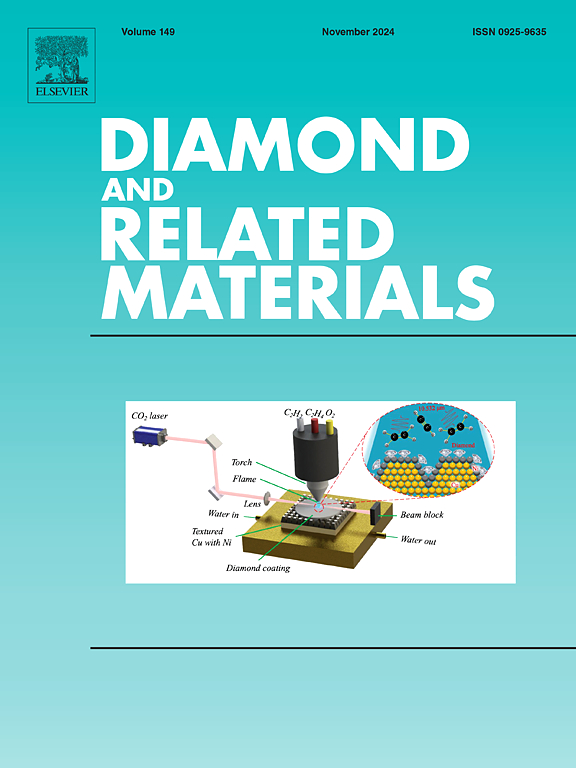煤源碳量子点修饰二氧化锰纳米线作为增强型水性锌离子电池的阴极
IF 4.3
3区 材料科学
Q2 MATERIALS SCIENCE, COATINGS & FILMS
引用次数: 0
摘要
锰基材料因其丰富的自然储量、低廉的生产成本和较高的理论容量而被广泛用作水性锌离子电池的正极材料。然而,它们对歧化反应的敏感性和易溶解,极大地阻碍了它们的实际应用。为了解决这些挑战,首先以无烟煤粉末为原料,通过溶剂热法合成了煤基碳量子点(CQDs)。这些CQDs随后与二氧化锰(MnO2)结合,形成MnO2@CQDs复合材料,用作azib的阴极材料。CQDs掺入MnO2中引入了额外的活性位点,有效地提高了MnO2的导电性和稳定性。结果表明,合成的MnO2@CQDs复合材料具有优异的电化学储锌性能。具体来说,它们在0.1 a g−1电流密度下提供了160 mAh g−1的比容量,并且在1 a g−1电流密度下循环500次后保持了95.4%的初始容量。本研究为锰基正极材料的发展提供了一个新的思路,通过整合高附加值的富土煤源CQDs作为促进剂,为AZIBs技术的发展提供了希望。本文章由计算机程序翻译,如有差异,请以英文原文为准。

Coal-derived carbon quantum dots modified MnO2 nanowires as cathode for enhanced aqueous zinc-ion battery
Manganese-based materials are widely used as cathode materials in aqueous zinc-ion batteries (AZIBs) because of their abundant natural reserves, low production costs, and high theoretical capacity. However, their susceptibility to disproportionation reactions and ease of dissolution, significantly hinder their practical applications. To address these challenges, coal-based carbon quantum dots (CQDs) were first synthesized via a solvothermal process using anthracite powder as the raw material. These CQDs were subsequently combined with manganese dioxide (MnO2) to create MnO2@CQDs composites for use as cathode materials in AZIBs. The incorporation of CQDs into MnO2 introduced additional active sites, effectively enhancing the conductivity and stability of MnO2. As a result, the synthesized MnO2@CQDs composites exhibited superior electrochemical zinc storage performance. Specifically, they delivered a specific capacity of 160 mAh g−1 at a current density of 0.1 A g−1, and maintained 95.4 % of their initial capacity after 500 cycles at 1 A g−1. This study provides a new idea for the development of manganese-based cathode materials by integrating value-added earth-abundant coal-derived CQDs as a promoter, offering promise for the advancement of AZIBs technology.
求助全文
通过发布文献求助,成功后即可免费获取论文全文。
去求助
来源期刊

Diamond and Related Materials
工程技术-材料科学:综合
CiteScore
6.00
自引率
14.60%
发文量
702
审稿时长
2.1 months
期刊介绍:
DRM is a leading international journal that publishes new fundamental and applied research on all forms of diamond, the integration of diamond with other advanced materials and development of technologies exploiting diamond. The synthesis, characterization and processing of single crystal diamond, polycrystalline films, nanodiamond powders and heterostructures with other advanced materials are encouraged topics for technical and review articles. In addition to diamond, the journal publishes manuscripts on the synthesis, characterization and application of other related materials including diamond-like carbons, carbon nanotubes, graphene, and boron and carbon nitrides. Articles are sought on the chemical functionalization of diamond and related materials as well as their use in electrochemistry, energy storage and conversion, chemical and biological sensing, imaging, thermal management, photonic and quantum applications, electron emission and electronic devices.
The International Conference on Diamond and Carbon Materials has evolved into the largest and most well attended forum in the field of diamond, providing a forum to showcase the latest results in the science and technology of diamond and other carbon materials such as carbon nanotubes, graphene, and diamond-like carbon. Run annually in association with Diamond and Related Materials the conference provides junior and established researchers the opportunity to exchange the latest results ranging from fundamental physical and chemical concepts to applied research focusing on the next generation carbon-based devices.
 求助内容:
求助内容: 应助结果提醒方式:
应助结果提醒方式:


